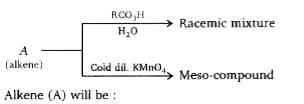Alkenes and alkynes burn with a .......... . flame.
Step-by-Step Solution:
1. Understanding Alkenes and Alkynes:
- Alkenes and alkynes are types of unsaturated hydrocarbons. Alkenes contain at least one carbon-carbon double bond (C=C), while alkynes contain at least one carbon-carbon triple bond (C≡C).
2. Combustion of Hydrocarbons:
- When hydrocarbons burn in the presence of oxygen, they undergo combustion. This process can be complete or incomplete depending on the amount of oxygen available.
3. Incomplete Combustion:
- Incomplete combustion occurs when there is insufficient oxygen. This leads to the production of carbon (soot) and water. The flame produced in this case is typically yellow and sooty due to the presence of unburnt carbon particles.
4. Complete Combustion:
- Complete combustion occurs when there is enough oxygen available. This results in the production of carbon dioxide (CO₂) and water (H₂O). The flame produced during complete combustion is blue, indicating a cleaner burn with no soot.
5. Conclusion:
- Therefore, alkenes and alkynes burn with a yellow and sooty flame during incomplete combustion, and a blue flame during complete combustion.
Final Answer:
Alkenes and alkynes burn with a yellow and sooty flame (incomplete combustion) or a blue flame (complete combustion).
---
- Alkenes and alkynes are types of unsaturated hydrocarbons. Alkenes contain at least one carbon-carbon double bond (C=C), while alkynes contain at least one carbon-carbon triple bond (C≡C).
- When hydrocarbons burn in the presence of oxygen, they undergo combustion. This process can be complete or incomplete depending on the amount of oxygen available.
- Incomplete combustion occurs when there is insufficient oxygen. This leads to the production of carbon (soot) and water. The flame produced in this case is typically yellow and sooty due to the presence of unburnt carbon particles.
- Complete combustion occurs when there is enough oxygen available. This results in the production of carbon dioxide (CO₂) and water (H₂O). The flame produced during complete combustion is blue, indicating a cleaner burn with no soot.
- Therefore, alkenes and alkynes burn with a yellow and sooty flame during incomplete combustion, and a blue flame during complete combustion.
Alkenes and alkynes burn with a yellow and sooty flame (incomplete combustion) or a blue flame (complete combustion).
Topper's Solved these Questions
- HYDROCARBONS BOOK - ICSECHAPTER - HYDROCARBONS EXERCISE - ASSERTION-REASON TYPE QUESTIONS
5 Videos
- HYDROCARBONS BOOK - ICSECHAPTER - HYDROCARBONS EXERCISE - NCERT TEXT-BOOK EXERCISES
46 Videos
- HYDROCARBONS BOOK - ICSECHAPTER - HYDROCARBONS EXERCISE - TRUE OR FALSE TYPE QUESTIONS
35 Videos
- EQUILIBRIUM BOOK - ICSECHAPTER - EQUILIBRIUM EXERCISE - NCERT TEXT-BOOK EXERCISE
109 Videos
- HYDROGENBOOK - ICSECHAPTER - HYDROGENEXERCISE - NCERT TEXT-BOOK EXERCISE (With Hints and Solutions)
53 Videos
Similar Questions
Knowledge Check

Alkene (A) will be :Acis-2-penteneBcis-2-hexeneCcis-4-octeneDtrans-2-hexene
Benzene burns with a luminous flame.
View SolutionWhat are alkynes?
View SolutionBurning is a
View SolutionWhy do alkenes and alkynes undergo addition reactions ? Describe some important addition reactions of alkenes and alkynes.
View SolutionHow do alkanes, alkenes and alkynes differ from each other with respect to Reaction with bromine water
View SolutionHow do alkanes, alkenes and alkynes differ from each other with respect to General formula
View SolutionHow do alkanes, alkenes and alkynes differ from each other with respect to Nature of bonds between carbon atoms
View Solution
